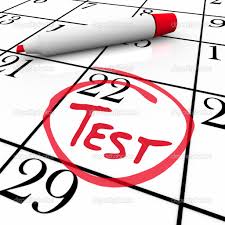
In previous posts in our series on the skills and habits of successful students, we reviewed the academic skills needed to acquire consistent strong grades without over-working. Today, we shift from academic skills to mental performance skills and the key executive function skill of planning and reviewing. This post is intended for high school students, a separate post on planning for college students will follow.
Why do teens procrastinate?
The life of a student during the teen years is filled with many external and school-related obligations. Much of the difficulty that teens face flows from the endless stream of readings, tests, papers, and assignments. Schoolwork is like an ever-ringing bell, always playing in the back of one’s mind. Procrastinators do not escape the noise and anxiety of incomplete assignments and tasks, they simply turn down the volume of the ringing bell and raise the volume of distractions like television, videogames, messaging, and social media. Even while playing their favorite videogame or texting with a friend, the procrastinating student ruminates about the work that is being avoided or delayed. There is no pleasure gained in the aversive actions and tasks; instead anxiety casts a dark shadow over the activities that could be fun and relaxing.
Much of this aversive behavior is wasted time that could be spent having satisfying experiences in social or extra-curricular pursuits. At most high schools, preparation, reading, studying for tests, and completion of all assignments can be done in 12 hours per week or less.In the end, time spent on aversion, procrastination, and cheap distractions leads to a doubling or tripling the time spent on “work” and a dramatic reduction in the amount of time spent on truly enjoyable tasks and experiences.
With some minor adjustments, any teen can get good grades and have lots of fun
Most students would find that they have plenty of time for satisfying fun, relaxation, and engaging interests if they would exercise a minimum amount of control and structure in how they use their time outside of classes. Very few high school and college students plan their week in advance. Only a handful of students track deadlines and upcoming test dates on a regularly viewed calendar or whiteboard. Most students have little idea of the actual amount of time needed to complete a particular academic task. How many students ask each week these simple, but critical questions: “What will be fun this week? What are the most important tasks to be completed? What will I do for relaxation?”
Successful students do not behave like the typical American adolescent in their teens and twenties. Successful students understand that the goal in life is to have plenty of fun and to master schoolwork in the least number of hours and most efficient manner possible. In fact, one would find that successful students have more satisfaction and fun in their lives than the average student because they do not waste countless hours avoiding their work. Instead, successful students make and stick to a plan that includes lots of time for fun and relaxation and an allotment of adequate time to efficiently complete all of their obligations and assignments.
Successful student profile #1: Johnny, football player
To put more detail to the above example let’s look at two high school students as examples. Johnny plays football for his school and does not return home until 6pm each school night. He takes 3 AP courses including US History, English, and Pre-Calculus resulting in an average of 10 to 12 hours of reading, homework, and test preparation each week. From Monday to Thursday evenings, he allots 2 sessions of 45 minutes and one session of 30 minutes to schoolwork.
Johnny’s typical schedule upon returning from practice is thus: from 6 to 6:15pm, he has a snack to refill his store of energy after practice. From 6:15 to 7pm, he works on the class assignments due the next day. From 7 to 8pm, he eats dinner with family and watches a bit of television. From 8 to 8:45pm, Johnny completes another focused session of reading, homework, or test preparation. After a 15 minute break, Johnny works from 9 to 9:30pm. From 9:30 to 10pm, Johnny checks his Facebook account, sends some texts to friends and girlfriend, and watches the highlights on ESPN. By 10pm, Johnny is ready for bed and falls right to sleep after a long and taxing day. Johnny sleeps soundly because he knows that 2 hours of work each school night and a couple hours on the weekend is all that is needed to complete his assignments and appropriately prepare for upcoming classes.
Fridays after school between August and Christmas are for football, so Johnny Dos not allot any time for Friday school work. After the game, Johnny showers and heads home. He typically meets up with his girlfriend on Friday nights after the game, but sometimes goes home and relaxes by watching TV and texting teammates about the game before heading off to bed. Johnny realizes that his commitment to football leaves him less time for his social life and other interests during the season, so he makes sure to have some fun and engaging outlets on the weekend.
Every Saturday morning, Johnny gets up by 9am and takes a guitar lesson at 10am. Lunch each Saturday is spent with his girlfriend or a buddy to catch up on the latest happenings. Saturday after lunch, Johnny takes a nap for an hour or two, and gets in a study session from 4 to 4:45pm. From 4:45 to 5pm, Johnny checks the college football scores and snacks. At 5pm Johnny spends an additional 45 minutes on schoolwork. Johnny spends 6-7pm working on his guitar lesson for the week. Saturday nights are for watching college football and pizza with teammates and friends or a dinner date with his girlfriend. Johnny is usually in bed by 1am and rises on Sunday by 10am.
After Sunday breakfast and a shower, Johnny puts in a 45 minute study session from 11 to 11:45am, then eats lunch and watches the Houston Texans game until 3:30pm or so. Some Sunday afternoons, Johnny will go to church with his family, but more often he will meet up with friends for some intensive Madden football games on the PS4. He’s usually back home by 5pm for an hour nap and then eats a snack from 6-6:15pm. He is energized and focused for a 45 minute study session that lasts from 6:15-7pm. At 7, Johnny and his family gather for a routine Sunday dinner. At 8pm, Johnny takes a deep breath and hits the books for another session of school work. By 8:30pm, Johnny is done with his work and has the rest of the evening to do as he pleases. He’ll spend 15 or 20 minutes planning the week ahead and reviewing the previous week’s plan. Usually, he watches the second half of the Sunday night football game, but other times, he’ll call his girlfriend or play some video games to relax.
Johnny does not have the Sunday night blues, because he closes the week with the confidence that he’s well-prepared for the days ahead. He spent 11.5 hours on school work in the previous week and doesn’t feel overburdened by working too much or feeling like he’s deprived of a good social life. Johnny is a happy, healthy, and active young man who keeps an A minus GPA in a challenging curriculum.
Successful student profile #2: Jane, top 10% of her class
Jane is a high school classmate of Johnny’s. She is also in the AP program and typically has 12 to 15 hours of schoolwork each week. Jane is home from school by 4pm each day and spends the first half hour upon returning home sending some texts to friends and eating a snack. At 4:30pm, she goes to her room for a 45 minute session of schoolwork. At 5:15pm on Mondays and Wednesdays, she gathers her Tae Kwon Do gear and heads to the martial arts studio. From 5:30 to 6:30pm on Mondays and Wednesdays, she’s in Tae Kwon Do classes. On Tuesdays and  Thursdays at 5:30pm, she goes to Starbucks for a meeting with her fellow microfinance club members. The group is working on a plan to raise $5000 for female entrepreneurs in Pakistan. From 6:30-7pm each day, Jane either showers after Tae Kwon Do or relaxes with an episode of her favorite shows on Netflix. At 7pm, she has dinner with her mom and sister for about an hour. From 8 to 8:45, Jane spends another 45 minutes on school assignments and reading.
Thursdays at 5:30pm, she goes to Starbucks for a meeting with her fellow microfinance club members. The group is working on a plan to raise $5000 for female entrepreneurs in Pakistan. From 6:30-7pm each day, Jane either showers after Tae Kwon Do or relaxes with an episode of her favorite shows on Netflix. At 7pm, she has dinner with her mom and sister for about an hour. From 8 to 8:45, Jane spends another 45 minutes on school assignments and reading.
At 8:45, Jane takes time to watch another episode of her Netflix show while sending texts and checking Snapchat. From 9:30 to 10pm, Jane has a shorter schoolwork session. At 10pm, Jane gets ready for bed and usually falls asleep by 11pm.
On Fridays after school, Jane completes her usual 4:30-5:15pm session of studying. She usually naps from 5:15 until 6 or so, then watches some Netflix and texts her friends to make a Friday evening plan. A friend’s band is playing an all ages show at Walter’s Downtown, so they meet up at Brazil Cafe in Montrose for some pre-show coffee and dinner. The concert is over by 11pm and the gang disperses. Jane is asleep by midnight on Friday evening.
Saturdays, Jane wakes at 8:30am and works the morning shift as a cashier at Kuhl-Linscomb from 10am-2pm. She loves talking with customers and her supervisor about the chic housewares on offer. Jane hopes to become an  interior designer, so the day of work is always satisfying. At 2pm, Jane heads home for lunch and a nap. By 4pm Jane is re-energized and ready for a 45 minute schoolwork session. She has a snack at 4:45pm and then spends 5 to 5:45pm reading the week’s upcoming government chapter. At 6, she hops in the shower and dresses for Cheryl’s birthday party at Ruggles Green. Dinner is at 7 and they hang around for another hour at Ruggles before leaving at 9. Jane and her friends gather at Cheryl’s house to watch a movie and have some birthday cake. By midnight, the gang is out of gas, so Jane drives home and falls asleep by 1am.
interior designer, so the day of work is always satisfying. At 2pm, Jane heads home for lunch and a nap. By 4pm Jane is re-energized and ready for a 45 minute schoolwork session. She has a snack at 4:45pm and then spends 5 to 5:45pm reading the week’s upcoming government chapter. At 6, she hops in the shower and dresses for Cheryl’s birthday party at Ruggles Green. Dinner is at 7 and they hang around for another hour at Ruggles before leaving at 9. Jane and her friends gather at Cheryl’s house to watch a movie and have some birthday cake. By midnight, the gang is out of gas, so Jane drives home and falls asleep by 1am.
Sundays, Jane wakes up at 10am for pancakes with her mom and sister. After breakfast and a shower, Jane heads out for a run in the neighborhood. By noon, Jane has finished her run and is ready for a light lunch. At 1pm, Jane sits down at her desk for 45 minutes of studying. From 1:45 to 3pm Jane checks her Snapchat account and makes a short video to share with her close friends. At 3pm, Jane gets to work on another 45 minute session of studying. She takes a break from 3:45 to 4pm and then spends another 45 minutes on schoolwork. From 4:45 to 6pm, Jane meets with Cheryl for ice cream at Amy’s Ice Cream. At 6, Jane gets home and spends 45 minutes studying prior to dinner. The family gathers at 7 for Sunday dinner and afterward Jane heads to her room for a bit more studying. From 8 to 8:45pm, Jane completes her last schoolwork session for the week and follows up with 15 minutes of planning and reviewing. From 9-11pm, Jane relaxes and watches Netflix shows and YouTube videos. She falls right to sleep when she finally hits the bed at 11:15pm on Sunday night.

For the week, Jane spent 12 hours and 30 minutes on schoolwork and had lots of time for fun and relaxation. She also worked for 4 hours at a job that she finds highly fulfilling. Jane is very skilled at using her time well and does not waste her time with silly distractions. She has lots of close friends and is developing her career with time spent on her entrepreneurship club and on the job. Even with her heavy load of schoolwork, Jane still has time for her favorite shows on Netflix, plenty of exercise with running and Tae Kwon Do, and letting loose at concerts and events each weekend. Jane is an A student, in the top decile of her class, and is one of the most popular gals on campus.
If you or your teenager is not using his or her time to have lots of fun, get strong grades, and have plenty of time for relaxation, then you need our Teen Independence Program. We teach and integrate a system for organization and time-management that any teen can use to build a life that is satisfying and productive. Every teen can learn how to: plan and review for learning, productivity, and refinement, keep track of deadlines, break long-term projects into small, achievable tasks, and to maintain a productive and positive outlook.


















